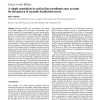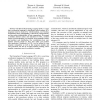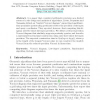1132 search results - page 95 / 227 » On coordination, autonomy and time |
FUIN
2008
13 years 11 months ago
2008
Abstract. Software systems evolve over time. From a component-based software engineering perspective, this means that either the components of the system need to change, or, if com...
BC
2004
13 years 11 months ago
2004
During saccadic eye movements, the visual world shifts rapidly across the retina. Perceptual continuity is thought to be maintained by active neural mechanisms that compensate for ...
RTSS
2009
IEEE
14 years 6 months ago
2009
IEEE
Abstract—The Hierarchical Timing Language (HTL) is a realtime coordination language for distributed control systems. HTL programs must be checked for well-formedness, race freedo...
GLOBECOM
2008
IEEE
14 years 5 months ago
2008
IEEE
Abstract— The coexistence and resource sharing between a primary network utilizing cognitive relays and a secondary network are investigated. Two multiple access protocols are pr...
WADS
2009
Springer
14 years 3 months ago
2009
Springer
In a paper that considered arithmetic precision as a limited resource in the design and analysis of algorithms, Liotta, Preparata and Tamassia defined an “implicit Voronoi diagr...



